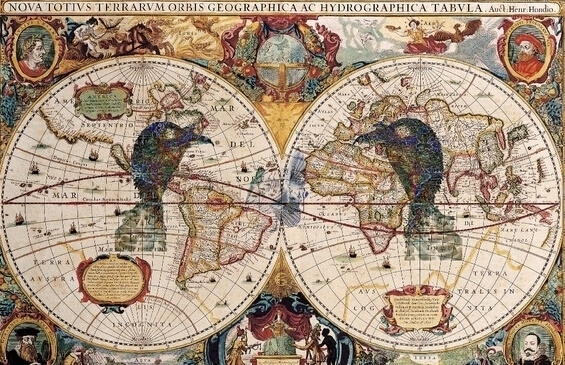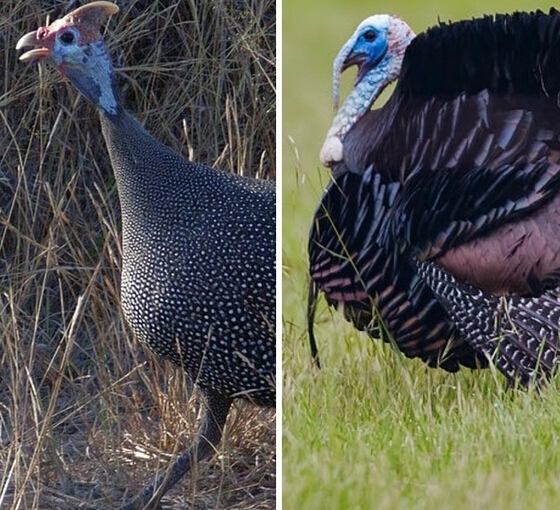How a New World bird came to be named after countries halfway around the globe.
這種新世界的鳥類為什么會(huì)以半個(gè)地球外的國家的名字來命名。
Within the turkey lies the tangled history of the world.
在土耳其境內(nèi)有著錯(cuò)綜復(fù)雜的世界歷史。

OK, not quite. But not far off, either.
好吧,或許并非如此,但也相差無幾了。
"Turkey" the bird is native to North America. But "turkey" the word is a geographic mess—a tribute to the vagaries of colonial trade and conquest. As you might have suspected, the English term for the avian creature likely comes from Turkey the country. Or, more precisely, from Turkish merchants in the 15th and 16th centuries.
"火雞"這種鳥是原產(chǎn)于北美洲。但是"turkey"一詞來源是一種地理上的大雜燴 — — 是對(duì)殖民地貿(mào)易和征服的異想天開的獻(xiàn)禮。你可能認(rèn)為這種鳥類的英文名字可能來自于土耳其這個(gè)國家的名字。或者,更確切地說,從第十五和十六世紀(jì)的土耳其商人那里得名。
How exactly the word "turkey" made its way into the English language is in dispute. The linguist Mario Pei theorized that more than five centuries ago, Turks from the commercial hub of Constantinople (which the Ottomans conquered in the mid-15th century) sold wild fowl from Guinea in West Africa to European markets, leading the English to refer to the bird as "turkey cock" or "turkey coq" (coq being French for "rooster”), and eventually "turkey" for short. When British settlers arrived in Massachusetts, they applied the same terms to the wild fowl they spotted in the New World, even though the birds were a different species than their African counterparts. The etymology expert Mark Forsyth, meanwhile, claims that Turkish traders brought guinea fowl to England from Madagascar, off the coast of southeast Africa, and that Spanish conquistadors then introduced American fowl to Europe, where they were conflated with the "turkeys" from Madagascar. Dan Jurafsky, another linguist, argues that Europeans imported guinea fowl from Ethiopia (which was sometimes mixed up with India) via the Mamluk Turks, and then confused the birds with North American fowl shipped across the Atlantic by the Portuguese.
“土耳其”這個(gè)單詞如何出現(xiàn)在英語語言中依然有爭(zhēng)議。語言學(xué)家Mario 裴理推測(cè)大概在五個(gè)多世紀(jì)前,君士坦丁堡這個(gè)商業(yè)中心的土耳其人 (在15 世紀(jì)中葉被土耳其人征服)將來自西非幾內(nèi)亞的野禽(即珍珠雞)賣到歐洲市場(chǎng) ,所以那時(shí)的英國人稱這種鳥為"土耳其公雞",并最終以"土耳其"來簡(jiǎn)稱這種動(dòng)物。當(dāng)英國移民抵達(dá)(美國)馬薩諸塞州時(shí),在這塊新大陸上他們用同一個(gè)詞來稱呼他們?cè)谶@片土地上看到的野禽,盡管這里的野禽不同于非洲的那種。詞源學(xué)專家馬克福賽思說土耳其商人把幾內(nèi)亞的這種野禽從馬達(dá)加斯加帶到英國,而西班牙征服者把美洲的野禽引到歐洲,所以就和來自馬達(dá)加斯加的“土耳其”混合在一起了。丹 Jurafsky,另一個(gè)語言學(xué)家,認(rèn)為歐洲人通過馬穆魯克土耳其人從埃塞俄比亞 (有時(shí)候人們將埃塞俄比亞同印度混在一起了) 進(jìn)口幾內(nèi)亞野禽,然后與葡萄牙通過大西洋從北美進(jìn)口的野禽混淆在一起了。

The guinea fowl (left) vs.the North American turkey (Wikipedia)
珍珠雞(左圖)和北美火雞對(duì)比(圖片來源:維基百科)
Here's where things get even more bewildering. Turkey, which has no native turkeys, does not call turkey "turkey." The Turks "knew the bird wasn't theirs," Forsyth explains, so they "made a completely different mistake and called it a hindi, because they thought the bird was probably Indian." They weren't alone. The French originally called the American bird poulet d'Inde (literally "chicken from India"), which has since been abbreviated to dinde, and similar terms exist in languages ranging from Polish to Hebrew to Catalan. Then there's the oddly specific Dutch word kalkoen, which, as a contraction of Calicut-hoen, literally means "hen from Calicut," a major Indian commercial center at the time. These names may have arisen from the mistaken belief at the time that the New World was the Indies, or the sense that the turkey trade passed through India.
事情還要更復(fù)雜。土耳其當(dāng)?shù)貨]有火雞,他們也不把火雞叫做“turkey”。他們“知道這玩意不是他們國家的“, 福賽斯是這么解釋的,因此他們犯了一個(gè)完全不同的錯(cuò)誤,把火雞叫做hindi(印度語的意思),因?yàn)樗麄冋J(rèn)為這玩意也許是印度的。有這種想法的人不止是土耳其人。法國人一開始把這種美國雞稱為poulet d'Inde(字面意思為來自印度的雞),后來簡(jiǎn)稱為dinde,類似的稱謂也存在于波蘭語、希伯來語和加泰羅尼亞語中。還有一個(gè)非常奇怪的特定荷蘭語稱謂kalkoen,是從Calicut-hoen這個(gè)詞提煉出來的,字面意思是“來自卡利卡特的母雞”, 卡利卡特曾是印度的主要商業(yè)中心之一。這些名稱的來源也許是因?yàn)楫?dāng)時(shí)他們認(rèn)為新世界指的是西印度群島一帶,或者是認(rèn)為火雞貿(mào)易途徑印度。
So what is the bird called in India? It may be hindi in Turkey, but in Hindi it's arki. Some Indian dialects, however, use the word piru or peru, the latter being how the Portuguese refer to the American fowl, which is not native to Peru but may have become popular in Portugal as Spanish and Portuguese explorers conquered the New World. The expansion of Western colonialism only complicated matters: Malaysians call turkey ayam blander (“Dutch chicken”), while Cambodians opt for moan barang (“French chicken”).
那么火雞在印度被稱為什么呢?在土耳其他們稱之為hindi,但是在印度語里他們稱之為ṭarki。在一些印度方言里使用piru或者peru這個(gè)詞,后者是葡萄牙語對(duì)美國火雞的叫法,火雞的原產(chǎn)地不是秘魯,但是在西班牙和葡萄牙征服新大陸時(shí)在葡萄牙很受歡迎。西方殖民主義的擴(kuò)張使事情更加復(fù)雜:馬來西亞人把火雞叫做ayam blander(荷蘭雞的意思),緬甸人選擇了moan barang這個(gè)叫法(意思是法國雞)
Then there are the turkey truthers and linguistic revisionists. In the early 1990s, for instance, a debate broke out in the "letter to the editor" section of The New York Times over the possible Hebrew origins of the word "turkey." On December 13, 1992, Rabbi Harold M. Kamsler suggested (as a follow-up to a Thanksgiving-themed piece titled "One Strange Bird") that the New World fowl received its English name from Christopher Columbus's interpreter, Luis de Torres, a Jewish convert to Catholicism. In an October 12, 1492 letter to a friend in Spain, de Torres had referred to the American bird he encountered as a tuki, the word for "peacock" in ancient Hebrew and "parrot" in modern Hebrew (a more dubious version of this story claims that Columbus himself was a Jew who hid his identity in the aftermath of the Spanish Inquisition but drew on his lineage to christen the fowl).
然后出現(xiàn)了火雞真相者和語言學(xué)上的修正主義者。比如在1990年代初期的時(shí)候,在《紐約時(shí)報(bào)》的“給編者的話”板塊上就引發(fā)了一場(chǎng)有關(guān)“火雞”這個(gè)詞可能來自希伯來語的可能性的爭(zhēng)論。1992年12月13號(hào),猶太拉比Harold M. Kamsler認(rèn)為這種新世界飛禽的英文名字源于航海家哥倫布的口譯人員 Luis de Torres(他是一名猶太人,后來皈依天主教)。在1492年12月12號(hào)給西班牙一位朋友的信件中, Luis de Torres將他在美國遇到的這種飛禽稱為tuki,在古希伯來文中指的是“孔雀”的意思以及在現(xiàn)代的希伯來文中指的是“鸚鵡”的意思(而在一個(gè)更加可疑的故事版本中稱哥倫布本人就是個(gè)猶太人,在西班牙宗教法庭建立后他隱藏了自己的身份,但是利用自己的血統(tǒng)為這種飛禽命名)。
Kamsler's letter, however, was met with a firm rebuttal from the president of the Association for the Study of Jewish Languages, David L Gold. "Rabbi Kamsler's explanation, not original with him, is an old yarn spun in uninformed Jewish circles," Gold wrote. "Along with countless other pseudoscientific claims about supposed Hebrew influence on English and other languages, the myth of the Hebrew origin of 'turkey' was quietly exploded in volume 2 of Jewish Linguistic Studies (1990)."
Kamsler的看法遭到了猶太語言研究協(xié)會(huì)主席David L Gold的反駁。“拉比Kamsler的解釋簡(jiǎn)直胡說八道。可以在《猶太語言研究》的第二卷(1990)中找到證據(jù)證明:“火雞”這個(gè)詞并非來自希伯來語。
The turkey's scientific name doesn't make much more sense than its vernacular one. Its binomial nomenclature, Meleagris gallopavo, is a hodgepodge. The first name comes from a Greek myth in which the goddess Artemis turned the grieving sisters of the slain Meleager into guinea fowls. The second name is a portmanteau: Gallo is derived from the Latin word for rooster, gallus, while pavo is the Latin word for peacock. So, effectively, the official name for a turkey is guinea-fowl-rooster-peacock.
火雞的科學(xué)命名并不比它的俗稱更有意義。雙名命名法,Meleagris gallopavo(吐綬雞),本來就是一個(gè)大雜燴。第一個(gè)詞來自于希臘神話:月亮女神阿耳忒彌斯將被殺死的梅利埃格的悲傷姐妹變成了珍珠雞(guinea fowl)。第二個(gè)詞是一個(gè)混合詞:Gallo來源拉丁詞”公雞“,pavo來源拉丁詞”孔雀“。所以,最終,火雞的正式名稱就是:珍珠雞-公雞-孔雀(guinea-fowl-rooster-peacock)。
Reflecting on his interview with Mario Pei, NPR's Robert Krulwich noted that "for 500 years now, this altogether American, very gallant if not particularly intelligent animal has never once been given an American name." But the turkey does have many authentically American names—Americans just choose not to use them. After all, pre-Aztec and Aztec peoples domesticated the turkey more than a millennium before Columbus reached the New World (the Aztecs called the bird huehxolotl). There are numerous Native American words for the bird, including the Blackfoot term omahksipi'kssii, which literally means "big bird." It's a bit vague, sure, but it certainly beats guinea-fowl-rooster-peacock.
回顧語言學(xué)家利奧-佩(Mario Pei)的采訪,美國國家公共電臺(tái)(NPR)的羅伯特-科爾維奇(Robert Krulwich)提到過”500年來,所有美國人非常殷切期盼這種并不太聰明的動(dòng)物能有一個(gè)美國化的名字。”但是火雞卻有很多真正的美國名字,只是美國人沒選用而已。畢竟,在哥倫布到達(dá)新世界前,阿茲特克人馴養(yǎng)火雞(阿茲特克人稱火雞為“huehxolotl”)已經(jīng)超過一千年了。有很多原生美國詞匯形容這種鳥,包括黑腳部族把它叫做“omahksipi'kssii”,意思是“大鳥”。這么叫是有點(diǎn)含糊,沒錯(cuò),但是確實(shí)好過“珍珠雞-公雞-孔雀(guinea-fowl-rooster-peacock)”。




